Category — Illuminated Manuscripts
The Book of Kells in the News
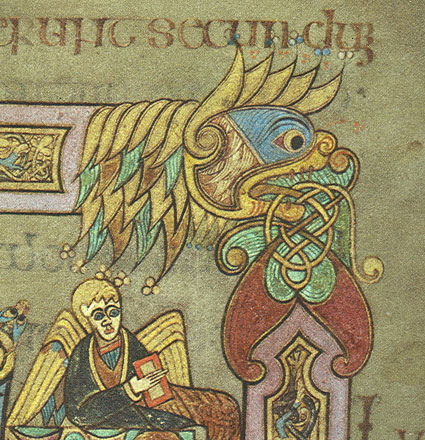
There may be no more famous example of an illuminated manscript than the Book of Kells. While it is well known as one of the most beautiful surviving illuminated manscripts, surprisingly, very little is actually known about the manuscript and its origins. Finally, modern science will be used to learn more about this treasure. From the Dublin Journal as reported in the New York Times:
Experts at Trinity College in Dublin, where the Book of Kells has resided for the past 346 years, are allowing a two-year laser analysis of the treasure, which is one of Ireland’s great tourist draws.
The 21st-century laser technology being used, Raman spectroscopy, encourages hopes among those with a romantic view for an ecclesiastical intrigue like “The Da Vinci Code†or “The Name of the Rose.â€
But the precise subjects are more mundane. The laser will study the chemicals and composition of the book, its pigments, inks and pages of fine vellum. Experts estimate that 185 calves would have been needed to create the vellum on which the art and scriptures were reproduced.
This news happens to coincide with the opening of The Medieval Scriptorium’s on-line gallery of images from the Book of Kells. I have to admit that the gallery is not complete. I haven’t had time to finish all of the captions for the images but I decided to introduce it in this post in light of the recent story referenced above.
[tags]Book of Kells, illuminated manuscript, celtic, calligraphy[/tags]
May 29, 2007 1 Comment
The Bedford and Sobieski Books of Hours Now on Display at the British Library
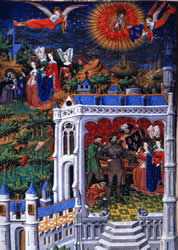 The Bedford Book of Hours is going to be on display at the British Library next week. This is one of the most magnificent illuminated manuscripts in the world. It dates from the early 15th century and every single page in the over 500 hundred page book of hours is illustrated. The illustrations and illuminations are vivid and lush. On display with the Bedford Hours is the Sobieski Hours. It is also from the early 15 century. Both illuminated masterpieces are credited to an artist known as the “Bedford Master.” From the 24 hour museum:
The Bedford Book of Hours is going to be on display at the British Library next week. This is one of the most magnificent illuminated manuscripts in the world. It dates from the early 15th century and every single page in the over 500 hundred page book of hours is illustrated. The illustrations and illuminations are vivid and lush. On display with the Bedford Hours is the Sobieski Hours. It is also from the early 15 century. Both illuminated masterpieces are credited to an artist known as the “Bedford Master.” From the 24 hour museum:
The British Library is displaying two masterpieces of medieval art together for the first time in an exhibition celebrating the 15th century artist, the ‘Bedford Master’, and the collections of the manuscript owners.
Running until July 2 2007, The Bedford Hours: Owners and Illuminators, brings the Bedford Hours and the Sobieski Hours together, both lavishly illustrated medieval manuscripts by the Bedford Master (so called in honour of his noble patron the Duke of Bedford).
The 24 hour museum continues:
The identity of the Bedford Master remains uncertain, despite his having been among the leading and most prolific painters of his day. Some scholars tentatively identify him as the Alsatian artist Haincelin of Hagenau, recorded in Paris as a court painter to the Dauphin Louis de Guyenne.
This may very well be a once in a lifetime opportunity to see the very best examples of Gothic Parisian illumination. These books are the pinnacle of Gothic calligraphic art.
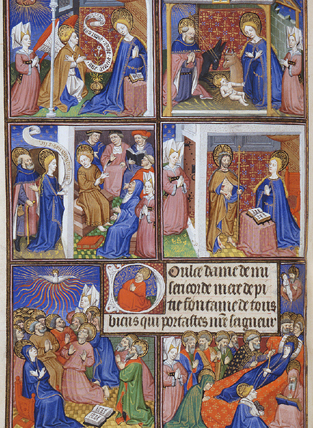
[tags]illuminated manuscripts, book of hours, bedford hours, sobieski hours, gothic alphabet, gothic calligraphy, british library[/tags]
April 16, 2007 Comments Off on The Bedford and Sobieski Books of Hours Now on Display at the British Library
The Book of Deer – Celtic Illuminations and the Oldest Known Gaelic from Scotland
 One of the most interesting Celtic manuscripts is The Book of Deer. It dates from the 10th century and is the earliest manuscript from an area of Scotland known as “former Pictland”. The Book of Deer is considered particularily important for the notes written in Gaelic in the margins of the original text. The Gaelic “scribbles” are the earliest record of written Gaelic from Scotland. From The Book of Deer Project web page:
One of the most interesting Celtic manuscripts is The Book of Deer. It dates from the 10th century and is the earliest manuscript from an area of Scotland known as “former Pictland”. The Book of Deer is considered particularily important for the notes written in Gaelic in the margins of the original text. The Gaelic “scribbles” are the earliest record of written Gaelic from Scotland. From The Book of Deer Project web page:
The Book of Deer is one of Scotland’s most important manuscripts. It is a small (54mm x 107mm) Gospel Book, now housed in Cambridge University Library. Before c. 1100 it was apparently in the possession of the early Columban monastery at Old Deer in north-east Aberdeenshire. This monastery has otherwise left no trace of its existence. A Cistercian Abbey was founded nearby in 1219. The Book of Deer came into the ownership of Cambridge University Library in 1715, when the library of the Bishop of Ely and Norwich was presented to the former by George I. Before that, the Book of Deer may have been in the possession of Dr Gale, High master of St Paul’s School (1672-97). The stages by which it moved from the North East of Scotland to the South of England are by no means clear. Even Cambridge University Library was unaware of its significance until it was ‘discovered’ in 1860 by the then librarian, Henry Bradshaw.
More information and images are available on The Book of Deer web page.
March 31, 2007 Comments Off on The Book of Deer – Celtic Illuminations and the Oldest Known Gaelic from Scotland
The Return of the Vita of St. Kentigern to Glasgow – A Continuing Mystery
 A book depicting the life of St. Kentigern, a sixth century saint, was commissioned in the latter part of the 12th century. The finished manuscript was kept in the Glasgow Catherdral and mysteriously disappeared 400 years ago. From the Medieval Sourcebook, here is a bit of the history of the celtic manuscript that vanished:
A book depicting the life of St. Kentigern, a sixth century saint, was commissioned in the latter part of the 12th century. The finished manuscript was kept in the Glasgow Catherdral and mysteriously disappeared 400 years ago. From the Medieval Sourcebook, here is a bit of the history of the celtic manuscript that vanished:
The oldest extant source for Kentigern is the fragmentary Life of Saint Kentigern. This life consists of a preface and eight chapters. The author is only describes himself as a cleric of St. Kentigern who had travelled a great deal, and the preface states that the life was composed at the request of Herbert, bishop of Glasgow from 1147 to 1164. The anonymous author said that he found his material for the Life of Saint Kentigern in a little book of his miracles and from oral tradition.
This fragmentary life was used at Glasgow for about 30 years. At that time a new life was written by Jocelyn, a monk of Furness Abbey in northern Lancashire. This life was written at the request of Bishop Jocelyn, who was Bishop of Glasgow from 1175 to 1199. Jocelyn, the author, was at Down in Ireland in 1185, and so it is likely that he wrote his Life of Saint Kentigern sometime before then, perhaps about 1180. Jocelyn also states that he used a little book, written in the Scottic style, as a source for his life, as well as the life already at Glasgow and oral tradition.
From the Evening Times:
It’s a long-running whodunnit that’s baffled investigators for 400 years – who stole Glagow’s most historic book? The Vita St Kentigern – the story of the city’s patron saint – disappeared from its home at Glasgow Cathedral four centuries ago. The culprit has never been traced, far less brought to justice. Now, finally, the book has returned …
Approximately 300 years ago, a copy of the original manuscript was acquired by Archbishop Marsh of Dublin and it was held safely in that library until two years ago when the book was scanned and used to create four new copies of the ancient hagiography. Thus, after 400 years the story of the life of St. Kentigern has returned to Glasgow, Scotland. A page of that manuscript is shown below.
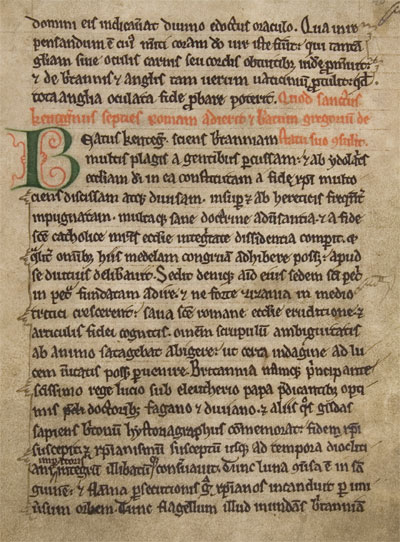
March 21, 2007 2 Comments
England’s Medieval Books of Hours – A New Book from Eamon Duffy
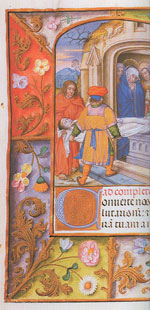 Of all the beautiful manuscripts from the Middle Ages that have survived, none is more common than Books of Hours. In fact, it has been said that “Books of Hours are now more widely scattered around the world than any other object made in the Middle Ages” ( from: “A History of Illuminated Manuscripts
Of all the beautiful manuscripts from the Middle Ages that have survived, none is more common than Books of Hours. In fact, it has been said that “Books of Hours are now more widely scattered around the world than any other object made in the Middle Ages” ( from: “A History of Illuminated Manuscripts“). Books of hours provided a framework for lay people to practice monastic devotional routines. After the upheaval of the Black Death in the 14th century, the popularity of the form surged and, by the later Middle Ages, these books were mass produced. One of the most famous and finely painted Book of Hours is the Très Riches Heures. My favorite illustration, however, is from the Hours of Catherine of Cleves, Duchess of Guelders (1417-1476). Shown below, this miniature shows an angel leading figures out of the mouth of Hell.
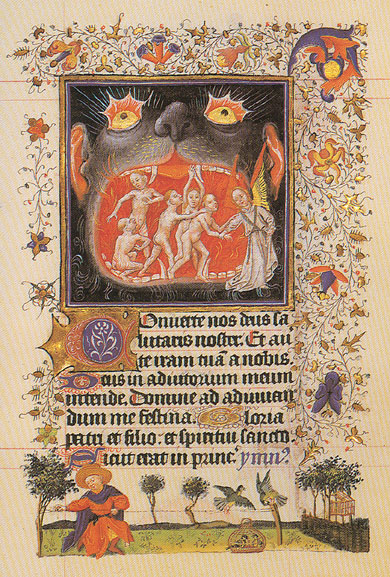
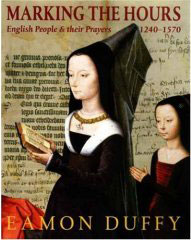 If you’re a fan of this type of illustration and calligraphy as I am, you’ll want to get your hands on a copy of a new book published on the Books of Hours by the religious historian Eamon Duffy. “Marking the Hours: English People and Their Prayers, 1240-1570
If you’re a fan of this type of illustration and calligraphy as I am, you’ll want to get your hands on a copy of a new book published on the Books of Hours by the religious historian Eamon Duffy. “Marking the Hours: English People and Their Prayers, 1240-1570” was reviewed in The Guardian recently. Duffy’s new book emphasizes the individual owners of these books. He’s most interested in the personal comments as well as the inclusion of commissioned images of the owners themselves in the beautiful miniatures. These additions are rare glimpses into the individual minds of people from the Middle Ages. From that review:
In the Middle Ages if you were female, comfortably-off and hoped to go to heaven then you almost certainly possessed a Book of Hours. Tucked up your sleeve or kept close by in a special place, the Book was your spiritual guide to the ordinary day. It didn’t speak intimately, nor was it interested in your particular circumstances. Instead it marked the passing of the liturgical “hours” – Matins, Prime, Vespers – giving you a set of prayers and psalms to raise your spirits as you negotiated a schedule more immediately concerned with sulky servants and sickly children than the glories of the Risen Christ.
The review in The Guardian continues:
The kinds of scrawls that people added to their Book of Hours included the names of favourite saints – Apollonia was good for toothache, while Zita was helpful with lost keys. If you were sufficiently rich and important you could get the artist to include a specially commissioned picture of yourself at the front of the book perhaps even – tricksy this – showing yourself reading the very Book of Hours in which you now metaphorically resided. There was even the option of getting yourself inserted into standard biblical scenes. One woman had herself painted as a spectator at the Annunciation, muscling in on Mary and Gabriel’s special moment. Others, more tactfully, waited until the Virgin was actually in heaven and had themselves painted floating on a nearby cloud.
I find this type of history fascinating and I’ve already pre-ordered my copy of Duffy’s book.
[tags]book of hours, eamon duffy, illuminated manuscript, calligraphy, medieval history, middle ages[/tags]
December 30, 2006 Comments Off on England’s Medieval Books of Hours – A New Book from Eamon Duffy

